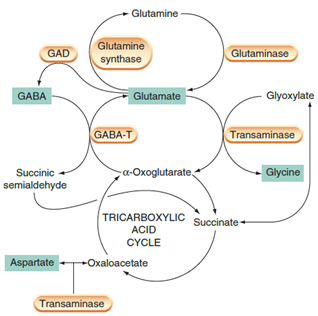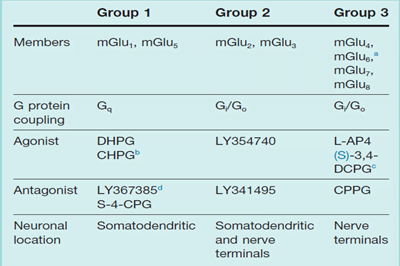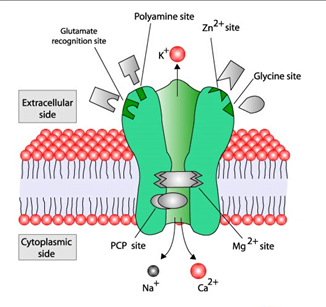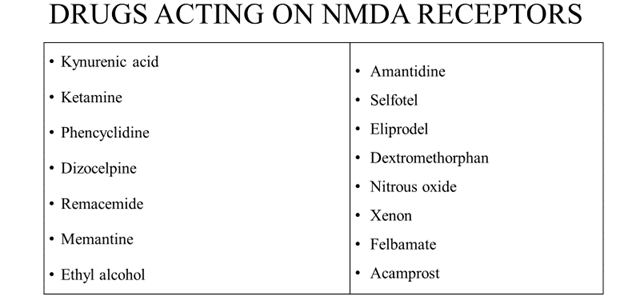Nmda Receptors And Drugs Acting On Them
Glutamate:
- Principal excitatory neurotransmitter
- Widely and uniformly distributed in CNS
- Derived from:
- Glucose via Kreb’s cycle
- Glutamine by glial cells.
- Stored in synaptic vesicles
- Released by Ca2+ dependent exocytosis
- Taken up by Na+/H+/K+ dependent transporters
- Action terminated by carrier mediated reuptake into nerve terminals and neighboring astrocytes.

GABA- Tà GABA transaminase;
GADà Glutamic acid Decarboxylase.
GLUTAMATE RECEPTOR SUBTYPES
- Metabotropic (G-protein coupled receptors)
- Ionotropic (Ligand gated ion channels)
METABOTROPIC RECEPTORS
- 8 different receptor types (mGlu 1-8)
- Functions as homodimers cross-linked by a disulfide bridge across extracellular domain of each protein.
- Divided into 3 groups.

IONOTROPIC RECEPTORS
- 3 main subtypes:
- NMDAà N-methyl D-aspartic acid
- AMPAà α- amino-3-hydroxy-5-methylisoxazole-4-propionic acid
- Kainate
- International Union of Basic and Clinical Pharmacology (IUPHAR)
- NMDA receptorsà 7 subunitsà GluN1; GluN2A; GluN2B; GluN2C; GluN2D; GluN3A; GluN3B
- AMPA receptorsà GluA1-4
- Kainate receptorsà GluK1-5
NMDA RECEPTOR

- Most important receptor
- Involved in processes like-
- Memory acquisition
- Development of synaptic plasticity
- Epilepsy
- Neuronal excitotoxicity due to cerebral ischemia.
- Pentamer; High permeability to Ca2+
- Widely distributed in spinal cord, hippocampus, cerebral cortex, glial cells.
- 6 pharmacologically distinct binding sites/modulatory sites:
- Glu (or NMDA) binding site
- Modulatory site for glycine
- Polyamines regulatory sites
- Phencyclidine binding site
- Voltage dependent Mg2+ binding site
- Voltage independent Zn2+ binding site.
- Important role in:
- Long term adaptive changesà synaptic plasticity
- Pathologic changes in brainà excitotoxicity
SYNAPTIC PLASTICITY
- Long term changes in synaptic connectivity & efficacy following:
- Physiological alterations in neuronal activity (memory & learning)
- Pathological disturbances (Epilepsy, pain, drug dependence)
- Mechanismà Long Term Potentiationà AMPA & NMDA play central role.
LONG TERM POTENTIATION
Long term potentiationà a prolonged (hours in vitro; days/weeks in vivo) enhancement of synaptic transmission occurring at various CNS synapses following short bursts of high frequency presynaptic stimulation.
These phenomena are studied at various synapses in CNS esp hippocampus (learning and memory)
- Long term depressionà produced at some synapses by longer train of stimuli and lower frequency.
- Characteristic featureà enhancement of synaptic strength following simultaneous activity in both pre & postsynaptic neurons.
- At normal membrane potentials, NMDA channels are blocked by Mg2+. A sustained post synaptic depolarization produced by glutmate acting on AMPA removes Mg2+ block leading to NMDA receptor activation and calcium entry into the cell.
- Rise in calcium in postsynaptic cell activates protein kinases, phospholipases and nitric oxide synthase which act jointly facilitating transmission via AMPA receptors.
EXCITOTOXICITY
- Glutamateà highly toxic to neuronsà excitotoxicity
- “Chinese restaurant syndrome”. -set of symptoms that some people have after eating Chinese food. A food additive called monosodium glutamate (MSG) has been blamed for the condition.
- Symptomsà Headache, Sweating, Skin flushing, Numbness in mouth & throat, nausea, fatigue
- Local injection of Glutamate agonist Kainic acidà excitation of local glutamate releasing neuronsà release of glutamate acting on NMDA and metabotropic receptorsà neuronal death.
- Calcium overload.
- Increased calcium affects many processes relevant to neurotoxicity. They are:
- Increased glutamate release
- Activation of proteases; Lipasesà membrane damage
- Increased arachidonic acidà increased free radical productionà inhibits glutamate uptake.

The potential therapeutic interest in ionotropic glutamate receptor antagonists lies mainly in the reduction of brain damage following strokes and head injury,
as well as in the treatment of epilepsy and Alzheimer’s disease. They have also been considered for indications such as drug dependence, schizophrenia and depression
KETAMINE AND PHENCYCLIDINE
- Together classified as “Club Drugs”
- Sold under the names “Angel dust”, “Hog”, “Special K”.
- Non-competitive antagonists of NMDA receptors
- Pure formsà white crystalline powders.
- Also available as liquids, capsules/ pills.
- Psychedelic effectsà 1 hour.
- Effectsà increased BP, Impaired memory function, visual alterations.
KETAMINE
- Congener of phencyclidine.
- Partially water soluble; Highly lipid soluble.
- Dissociative anesthesiaàprofound analgesia, immobility, amnesia with light sleep. Patient appears to be conscious that is eyes open, swallowing present, muscles shift but he is unable to process sensory stimuli and does not react to them.
- Primary siteà cortex, subcortical areas not in reticular activating system.
- MOAà Inhibition of NMDA receptor complex.
- ACTIONS:
- Analgesia
- Stimulation of sympathetic nervous system
- Bronchodilation
- Minimal respiratory depression
- Route of Administrationà IV, IM
- Dose: 1-2 mg/kg IV or 4-6mg/kg IM
- ADR: Psychomimetic effects.
ACAMPROSATE
- Antagonist of NMDA glutamate receptor
- Interferes with forms of synaptic plasticity that depend on NMDA receptors.
- Use: Rx alcoholism
- To be started soon after withdrawing alcohol and then given continuously at a dose of 666 mg 2-3 times a day.
- ADR: Allergic reactions; Arrhythmia; BP variations; Headache; Insomnia; Impotence; Hallucinations in elderly patients.
MEMANTINE
- Excitotoxic activation of glutamate transmission via NMDA receptorsà Contributes to pathophysiology of Alzheimer’s disease.
- Memantineà binds to NMDA receptor channels- produces a non-competitive blockade.
- Less toxic and better tolerated than other cholinesterase inhibitors.
AMANTADINE
- Antiviral agent -prophylaxis of influenza A2
- Weak anti-parkinsonism properties.
- An antagonist of NMDA receptor
- Uses:
- Parkinson’s Disease
- Iatrogenic dyskinesia
Overdoseà acute toxic psychosis
“Livedo reticularis’à headache, heart failure, postural hypotension, urinary retention, GI disturbances.
FELBAMATE
- Effective for partial seizures.
- Causes aplastic anemia and severe hepatitis.
- MOA:
- Produces use-dependent block of NMDA receptor with selectivity for NR1-2B subtype.
- Produces barbiturate like potentiation of GABAA receptor responses.
FLUPIRTINE
- Neither an opioid analgesic or a NSAID
- Not yet approved by US FDA
- Acts indirectly as NMDA receptor antagonist by activation of K+ channelsà hyperpolarization of neuronal membraneà neuron becomes less excitable.
- Causes a dose-dependent reduction of NMDA receptor mediated glutamate induced rise in intracellular Ca++ concentration
- Analgesic, Muscle relaxant, Antiparkinsonian
Idrocilamide; Riluzoleà newer drugs for treatment of Amyotrophic Lateral Sclerosis (ALS).
- Spasm reducing effects possibly through inhibition of glutamatergic transmission in CNS.
